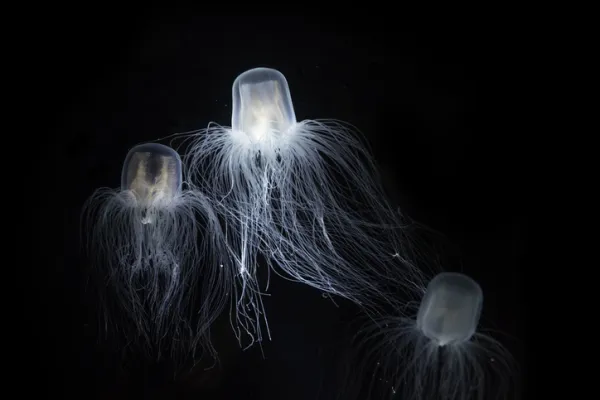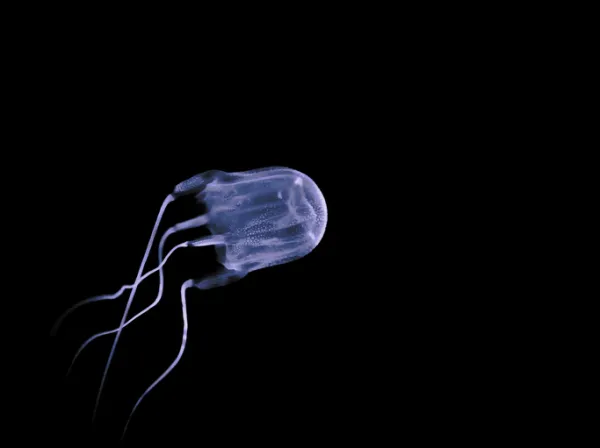The box jellyfish (Chironex fleckeri) is considered one of the most venomous creatures on Earth. A single individual contains enough venom to kill up to 600 people. Since 1954, this species has been linked to over 5,500 human fatalities. Its deadly nature has even been portrayed in films, often as a silent but lethal threat.
Curious about the world’s most dangerous jellyfish? In this article, we explore the box jellyfish’s features, where it lives, what it eats, and how its sting works.

Here are the main characteristics of the box jellyfish:
Highly venomous: It’s considered one of the deadliest animals on the planet.
Nicknames: Commonly called the sea wasp, box jelly, cubozoan, or cube jellyfish—due to its cube-like, boxy bell shape.
Tentacles: It has up to 60 tentacles, each measuring around 80 cm long, but they can reach 3 meters (10 feet) in adulthood.
Body size: The bell itself ranges from 10 to 20 cm wide (similar to a basketball).
Appearance: It’s translucent, pale bluish in color, and glows faintly in the dark.
Lifespan: Quite short—usually between 3 to 6 months.
Eyes: Unlike most jellyfish, which are blind, box jellyfish have 4 groups of 20 eyes, totaling 24. It’s still unclear how much they can see, but these visual organs help compensate for their lack of a brain.
Box jellyfish are mainly found in tropical waters of northern Australia, especially near the coasts of Queensland. They’re often swept closer to shore by ocean currents. Other locations where they've been observed include:
Papua New Guinea
Vietnam
The Philippines
Indian and Pacific Oceans
Warning season: From October to May, they approach the shore to reproduce. During this period, many beaches—like those in Queensland—ban swimming due to the high risk of stings.
They coexist with the Irukandji jellyfish (Carukia barnesi), a tiny relative that causes Irukandji syndrome, a painful and potentially fatal condition marked by nausea, high blood pressure, and heart palpitations.

Like other jellyfish, box jellyfish are passive hunters. They don’t chase prey but wait for it to float into their tentacles.
Diet: Includes plankton, small marine animals, and occasionally other jellyfish.
Feeding mechanism: Their venomous tentacles instantly paralyze and kill prey on contact.
Green sea turtles (Chelonia mydas) can eat box jellyfish thanks to their thick skin, which protects them from most stings.
The tentacles of the box jellyfish are lined with billions of specialized stinging cells called cnidocytes, each capable of injecting venom.
Severe pain
Tissue necrosis
Cardiac arrest
Paralysis or death within minutes
The venom is a complex mix of:
Myotoxins – damage muscles, including the heart
Hemotoxins – break down red blood cells
Neurotoxins – affect nerves and respiratory function
Dermonecrotic toxins – destroy skin tissue
Even a brief brush with a tentacle can cause excruciating pain, followed by unconsciousness or drowning. Survivors often show permanent scarring resembling deep whip lashes.
The venom is 10x more potent than that of the Portuguese man o' war and much stronger than common sea nettles (Chrysaora quinquecirrha).
In 2024, researchers at the University of Sydney developed an antidote for box jellyfish venom. They are now working on a topical treatment that could one day be used to treat sting victims and save lives.
The box jellyfish is a beautiful yet deadly marine creature. Its ghost-like appearance and transparent body hide one of nature’s most powerful venoms. Understanding its behavior, habitat, and biology helps us respect the oceans—and stay safe.
[Top 10 Most Poisonous Sea Creatures]
[How Jellyfish Reproduce]
[What to Do If You Get Stung by a Jellyfish]
Categories: Marine Animals | Dangerous Wildlife | Venomous Creatures
Bibliografía
Winter, K. L., Isbister, G. K., McGowan, S., Konstantakopoulos, N., Seymour, J. E., & Hodgson, W. C. (2010). A pharmacological and biochemical examination of the geographical variation of Chironex fleckeri venom. Toxicology letters, 192(3), 419-424.
Bloom, D. A., Burnett, J. W., & Alderslade, P. (1998). Partial purification of box jellyfish (Chironex fleckeri) nematocyst venom isolated at the beachside. Toxicon, 36(8), 1075-1085.
animal tags: box jellyfish